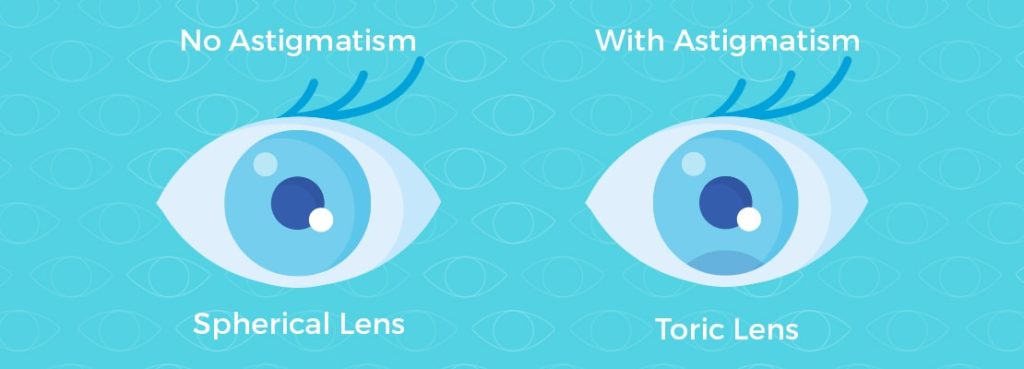When your eye shape is more football than basketball, you might have some vision problems. If your eyes are irregular in shape, you likely have some degree of astigmatism.
Luckily, the days of people with astigmatism being unable to wear contact lenses are long gone. Contact lens advancements have come so far that most people with astigmatism — even those switching from glasses for the first time — can be fitted with lenses.
If you have astigmatism, your optometrist will likely recommend toric lenses. Read on to discover more about astigmatism, what toric lenses are, and how they work.
What Is Astigmatism?
To understand astigmatism, you’ll have to first understand the role of the cornea.
The cornea is the clear, outer layer of the eye. It’s responsible for a couple of things. Firstly, it’s a protective layer. Secondly, it’s job is to refract (bend) and focus light that enters the eye.
If you have a cornea that isn’t shaped properly, that means it can’t focus light properly. Irregular-shaped corneas might give you blurry vision. When this happens, it’s called astigmatism.
You might have astigmatism in one or both eyes. It’s often accompanied by other refractive errors like myopia (nearsightedness). Myopia is caused by an eye shape that’s too long — if the eye is misshapen, chances are good the cornea is too.

Causes & Symptoms Of Astigmatism
Astigmatism is often hereditary and present at birth. You may also get it after injury to the eye or ocular surgery.
Many people have astigmatism — it’s pretty rare to find a perfectly formed eye.
Some common symptoms of astigmatism are:
- Blurry vision, no matter the distance
- Headaches
- Discomfort in the eye
Sometimes, astigmatism is a sign of keratoconus, another eye condition involving corneal shape. For people with keratoconus, the cornea becomes more cone-shaped as time goes on.
If you’re experiencing any symptoms of astigmatism, it’s important to visit your optometrist for a comprehensive eye exam. An exam will rule out any eye diseases or conditions that might be impacting your sight.
Toric Contact Lenses
If you have astigmatism and want to wear contact lenses, your optometrist might suggest toric lenses. These are special lenses that correct vision on both the horizontal axis and vertical axis of your eye. Toric lenses can have different powers in different parts of the lens.
The differing powers around the lens mean that toric contacts have to sit just right on your eye and stay in place so you can see clearly. They have unique design features that help them to do this.
Contact lenses can rotate when you blink. A regular, non-toric contact lens can rotate in your eye without issue — it won’t matter which portion of the lens is on top. When it comes to toric lenses, any rotation in the lens might make your vision blurry again.
Some toric lenses offer weighting at the bottom of the lens to make sure the contact assumes the appropriate alignment after a blink or two. This is called ballasting.
Toric contact lenses may also have thin-thick zones or a truncated bottom to help the lens stay in the appropriate location on the eye.
Options For Toric Lenses
Regular contact lenses come in many different types, as do toric lenses. You can get monthly lenses, daily disposable ones, soft or rigid gas-permeable lenses, or even colored contact lenses.
Don’t feel as though you’re going to be stuck with limited options just because of your astigmatism. Just talk with your optometrist and make sure you get fitted properly.
The Fit Is Critical
Contact lenses are a medical device. They sit directly on your cornea and it’s imperative that they fit properly,
Never guess at your prescription and try to order contact lenses yourself. Always check with your optometrist. They’ll provide you with a special eye exam to fit you for contact lenses.
Detailed eye measurements will be taken to ensure you get the proper fit. As with any lens, taking into account your lifestyle and environmental situation is important when choosing toric lenses.
It’s important to visit an experienced optometrist — fitting toric contact lenses requires skill and accuracy.
Pros and Cons of Toric Lenses
While toric contact lenses are generally a great option for people with astigmatism, there are pros and cons to consider.
Toric lenses, owing to their specialty design, might be more expensive than regular contact lenses. They also require a more precise fit. It might take trying a few different brands and styles of toric contact lenses to find the ones that work best for you. If the toric lens isn’t fitted perfectly, it will move around, making your vision blurry.
There are pros to choosing toric contact lenses instead of glasses. Contacts won’t fog up or have water droplets on then during inclement weather. You can play sports without risk of something falling off your face. You might also just prefer a glasses-free look.
Healthy Eyes & Toric Lenses
Astigmatism can get better or worse over time. It’s important to keep in contact with your optometrist and have regular comprehensive eye exams. Your eye care professional will monitor your sight and ensure that you’re receiving the care you need.



